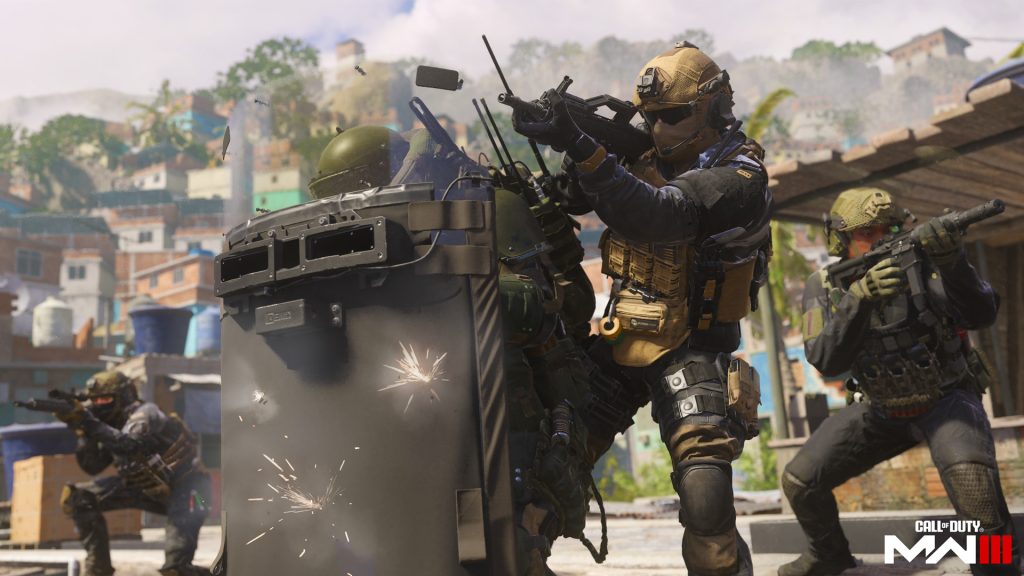
This week’s release of Call of Duty Modern Warfare 3 – the 20th game in the series – is a good reminder of a franchise that at first transformed shooters, and has since been a dominating factor in gaming over the past two decades. IGN has a useful interview with Mackey McCandlish, who was one of the instrumental developers in the early years of the franchise, when the series found its footing.
He talks about the kind of creative inspirations that brought forth one of the world’s most successful and enduring gaming intellectual properties, as well as the commercial and practical problems involved.
Relevant to all times, he also talks about the power of external cultural issues for developers who are seeking to tap into mainstream zeitgeist. Call of Duty games span multiple historical (and fictional) timelines, but began rooted in the public’s enduring interest in World War 2, and in fictional productions of the late 20th and early 21st Centuries, like the movies Saving Private Ryan, and the sublime television series Band of Brothers.
D-Day, all the time
McCandlish was an early employee at studio Infinity Ward, which had been set up by his colleagues from previous studio 2015 Inc. – Vince Zampella, Grant Collier, and Jason West. They had all worked on Medal of Honor: Allied Assault at 2015, on behalf of Electronic Arts. Medal of Honor was then the foremost WWII shooting franchise. Unhappy with EA, they had formed Infinity Ward to create a new franchise for Activision.
Although the team mulled a variety of games, including a fantasy slasher and a sci-fi shooter. “Jason used to say that the throughline for making a Call of Duty was ‘let’s do all D-Day all the time,” recalled McCandlish. “That’s a high bar to set.”
Medal of Honor: Allied Assault had been released on PC – and not console – because the game’s busy combat arenas required more power than was then available on PlayStation. But in 2002, when Infinity Ward was founded, new consoles, like PlayStation 2 and Xbox, were establishing themselves in the market, and setting higher expectations among consumers.
“Burnville [a Normandy landing section of Call of Duty] was one of the first levels we did,” said McCandlish. “We’re trying to have guns going off in the sky, paratroopers coming down, explosions, hills dynamically turning into like craters.” All this created a sense of the chaos of invasion, because it focused the player on a sense of being a part of something involving immense numbers of soldiers. This was what Zampella and the team wanted to achieve.
“No one fights alone,” said McCandlish. “You feel like you’re in a squad… There’s always friendly characters around you talking with you. They’re able to die. More of them are always coming through from some other off-screen point, creating that feeling all around that you’re in a war, and it’s real.”
He added: “It’s amazing how all those moments feel cinematic. You feel engaged … you have to crouch when the planes go by or you’re gonna get shot and killed.”
Thrash out ideas
In the interview, McCandlish says the team would meet at a local restaurant to thrash out ideas. Their inspirations weren’t so much other games, as TV shows and movies.
“That feeling of activity and a living world really differentiated what we were making. But I don’t think it was because we looked at other games and said they could be ‘more living’. It’s more like we watched a lot of Band of Brothers.
“There was a lot of careful attention paid to evoking emotion. There was an intentional emotion to achieve. Where did that come from? More likely it came from moments in film than it did from other games,” he said.
One of the major pillars of Call of Duty’s enormous success has been its multiplayer maps. Although the franchise has branched out into fantasy arenas, like zombies, the game’s early designers wanted to retain a sense of historical realism, down to the choice of weapons available.
“I have a lot of really positive memories of playing Call of Duty multiplayer on PC,” said McCandlish. “Back then you could put 64 players on a server. You’d play search and destroy – our version of Counter-Strike – and there were just so many targets and then once you’re dead, you’re out.
“When you’re playing British, you’re only getting British guns which was differentiating from [other multiplayer shooters] where everybody gets every gun. I think it had its own flavor. And it was a good PC multiplayer title for its time.”
Unlocking stuff
One clear innovation was allowing players to improve their load-out during bouts, leveling up weapons as they gained XP, something that became mainstream soon after. “It may seem obvious now, but internally that was very divisive – ‘you can’t do that, you’ve got to have fairness and you can’t have an unfair advantage’ – but we went with it, and it worked.”
He added: “It’s a personal journey of unlocking stuff. It’s nice because it gets you to play stuff you wouldn’t normally play. I think the designer’s job is to encourage the player to get out of their comfort zone a little bit, without turning them off from the game.”
As the years went on, more studios were drafted in by Activision to turn Call of Duty into a massive, annual franchise spanning multiple narratives and timelines. But the series’ multiplayer innovations and its sense of time and place has proved to be an enduring combination.
You can watch the full IGN interview here.
Colin Campbell has been reporting on the gaming industry for more than three decades, including for Polygon, IGN, The Guardian, Next Generation, and The Economist.
 GameDaily.biz © 2024 | All Rights Reserved.
GameDaily.biz © 2024 | All Rights Reserved.